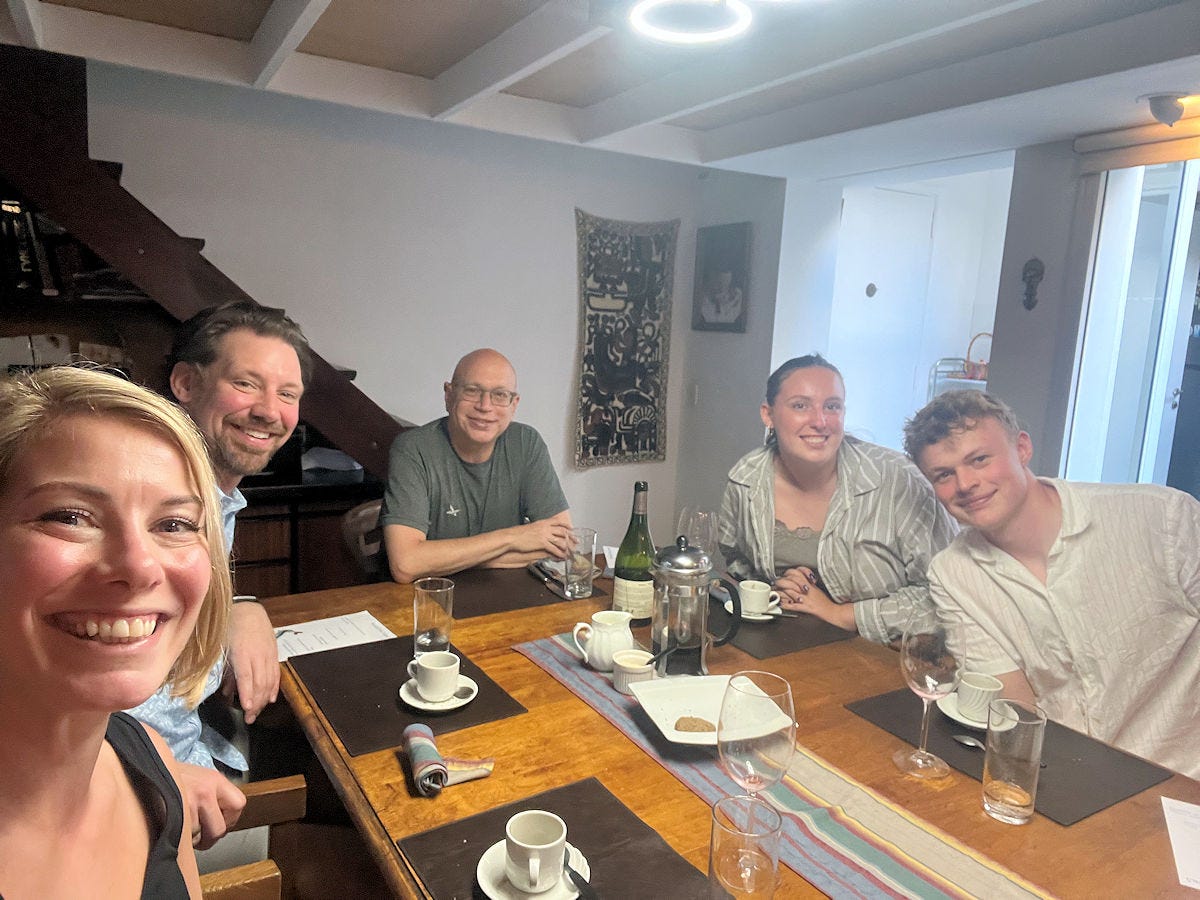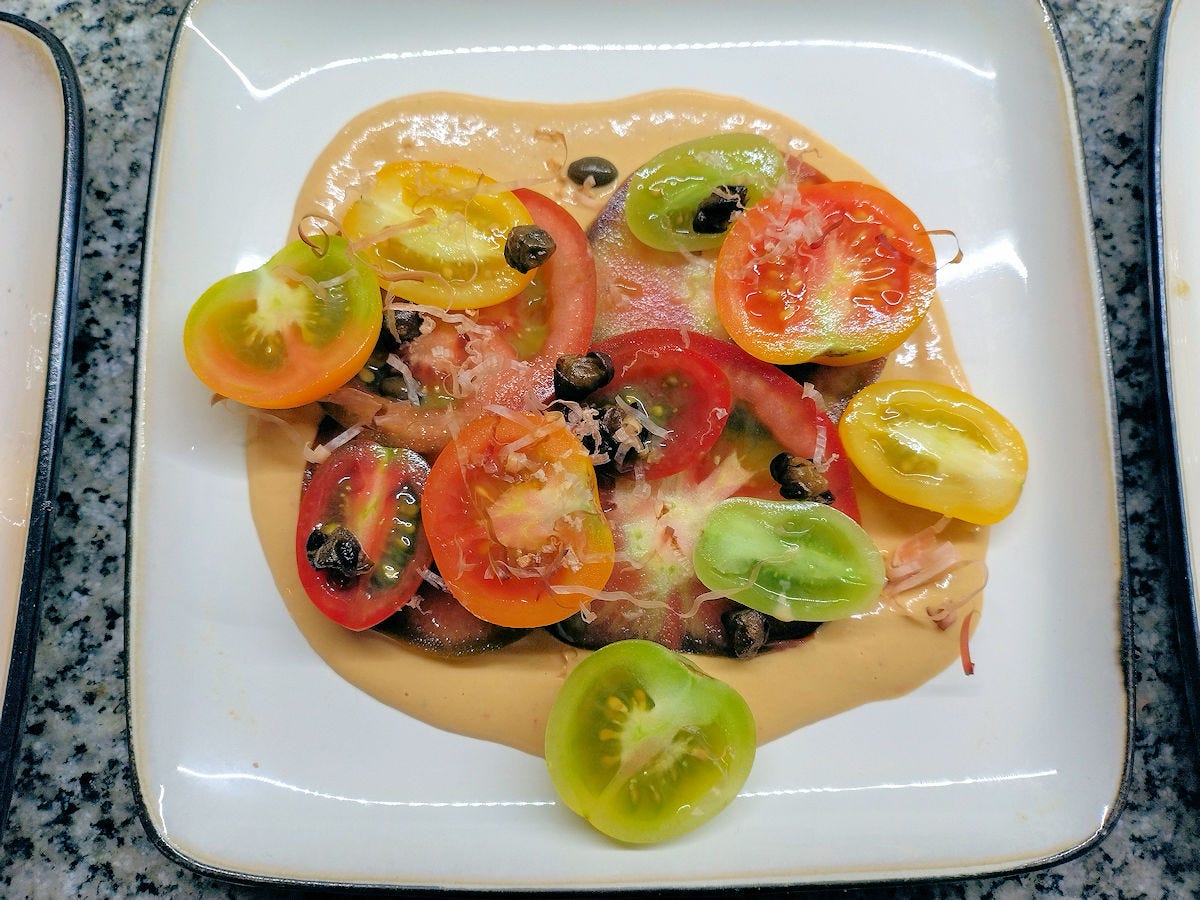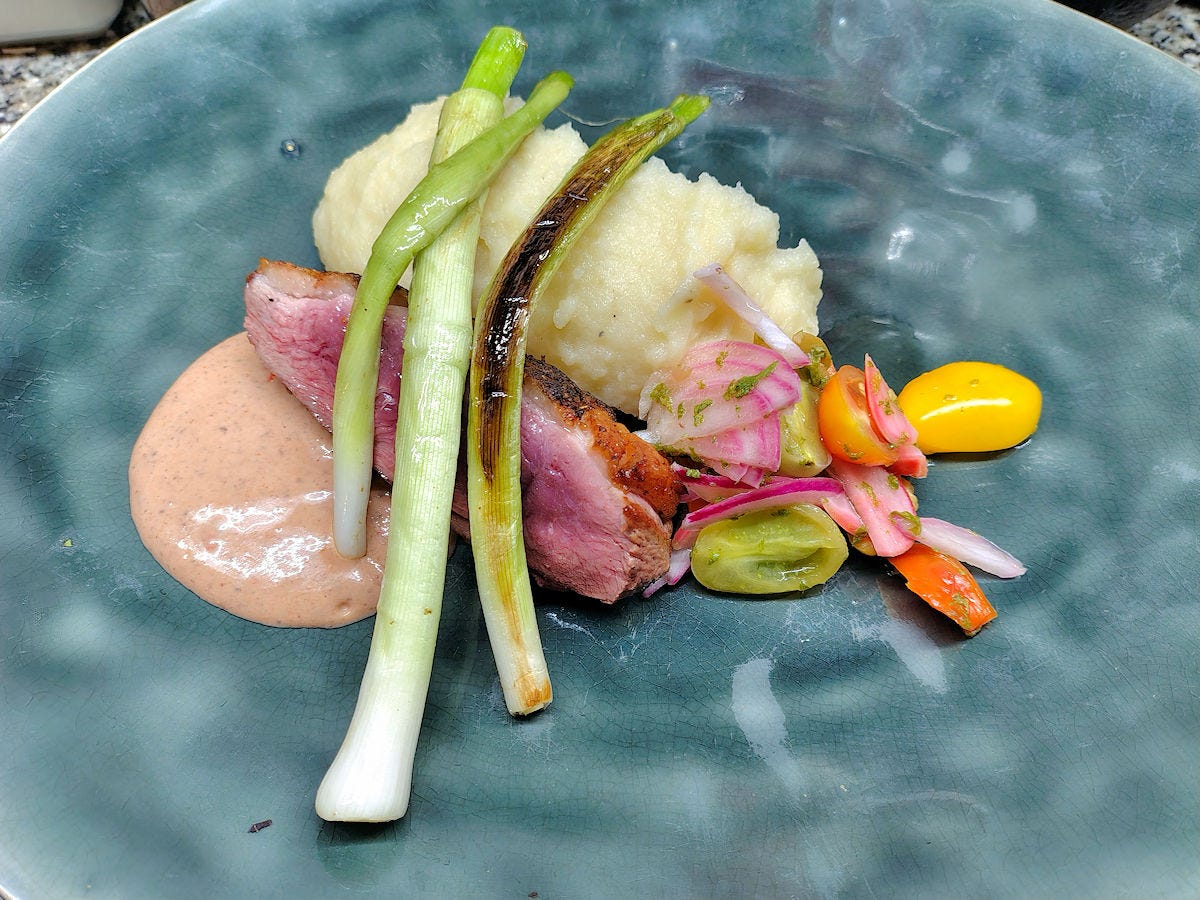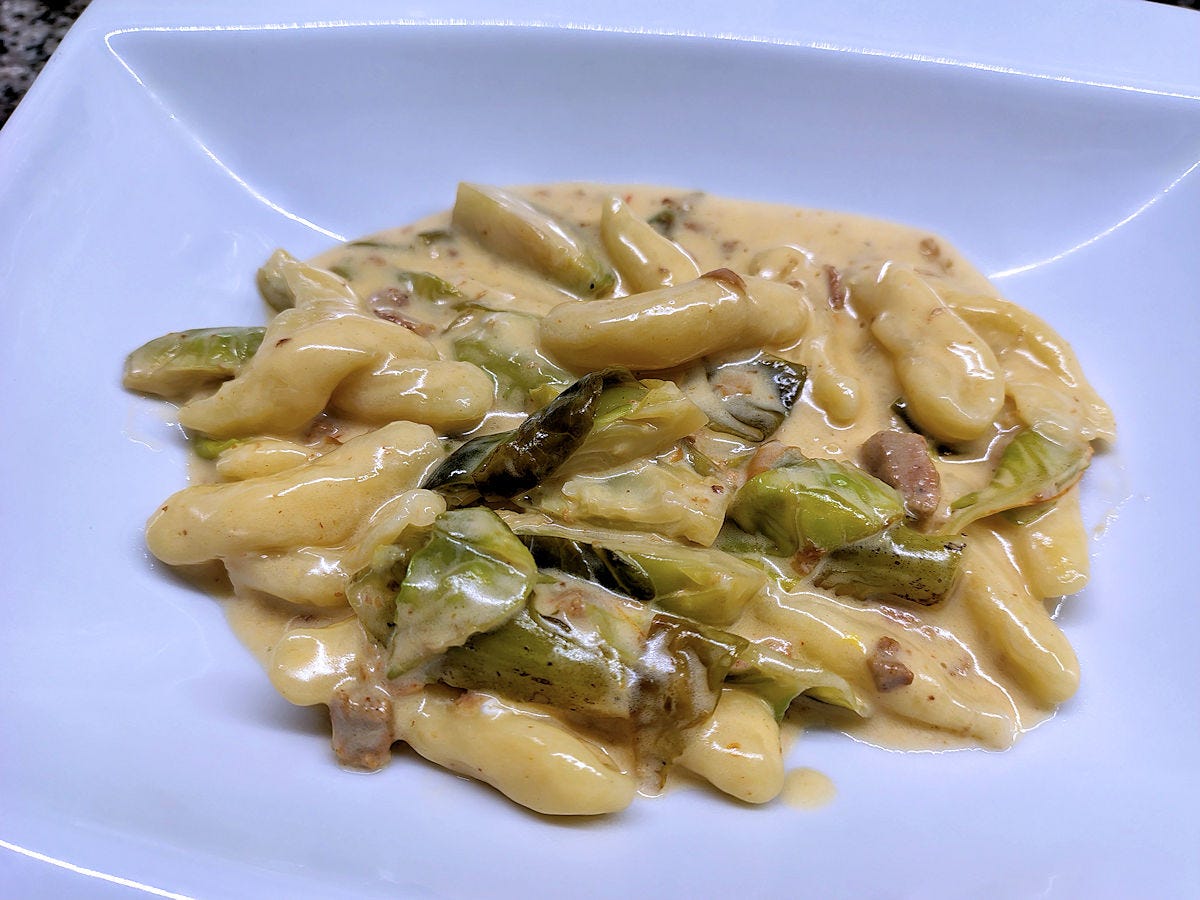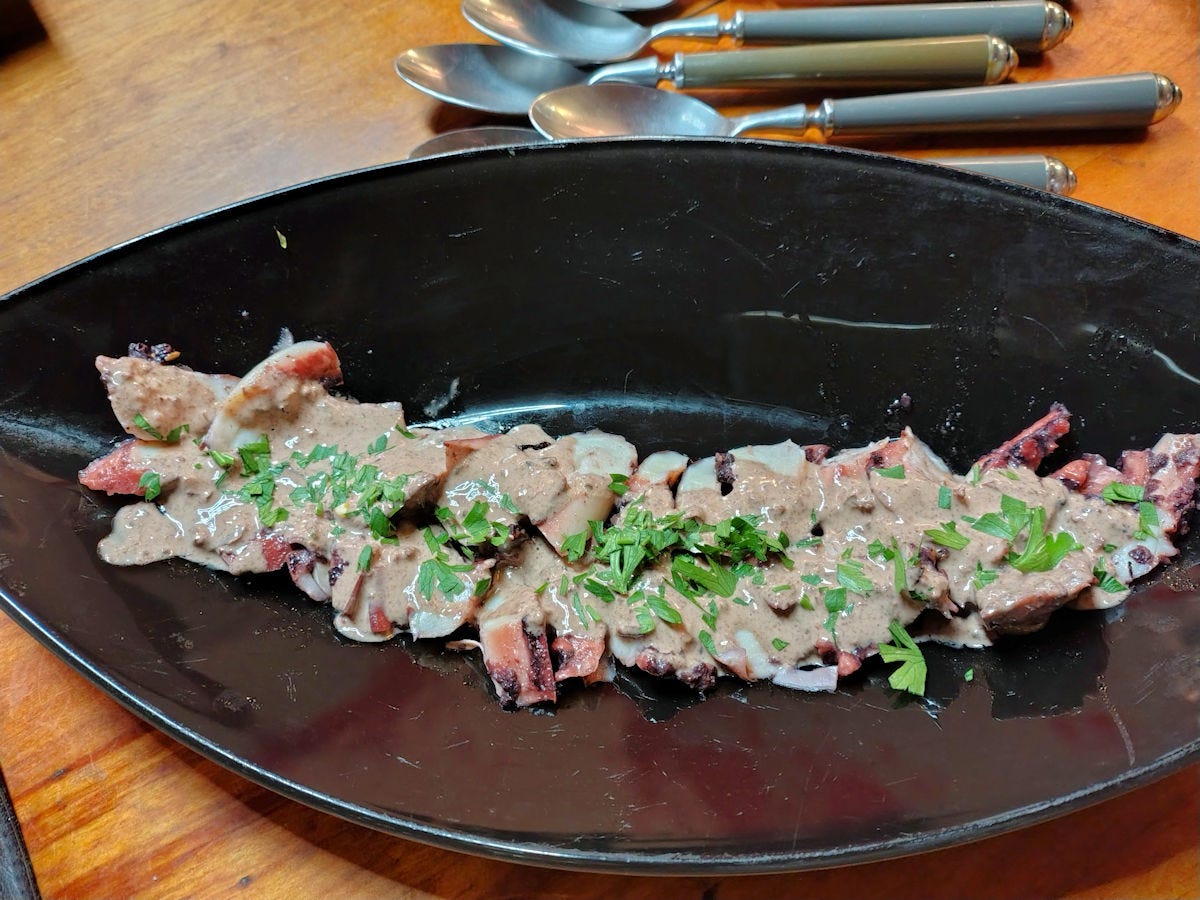The March of Casa S
In which we look back at last month's meals that graced our table.
March was a busy month here at Casa Saltshaker, with not only our long standing weekly dinners, but we’re experimenting with a once a week prix fixe lunch. A simple two course meal, focusing less on the experimental and more on the classics, with an appetizer followed by, usually, a pasta of some sort - Italian or otherwise - accompanied by an appropriate wine, and ending with coffee service including… cookies. I love cookies, and picking something that relates to the theme of the lunch makes, for me, a perfect finale. And, an encore finale, a look at our cooking classes.
This one was inspired by one of the dishes that I really enjoyed on my recent visit to Lima, at Frina restaurant. The dish was “lightly crisped sweetbreads bathed in a tucupi sauce - made from pureed yuca root, and served with a sort of “textures of carrot” - dehydrated powder below, a mound of puree to the side, and lightly cooked carrot “flowers” or cones, with cardamom seeds.”
Now, obviously a very different dish. I took the flavor profile rather than the form. I made pansôti of a carrot puree and semolina dough, filled with a puree of taro root, caramelized onion, and cardamom. The sauce is a creamy pesto made from the carrot tops, green chili, pinenuts, roasted garlic, white pepper, cardamom, and a local cheese, atuel. Tossed the pansôti with that and then topped with par-cooked diced sweetbreads dusted in farofa, taro root flour, sautéed with finely diced carrots and green onion. I was going to dust the plate with dehydrated carrot powder, but the only source of that here was out of stock.
Served with Amalaya’s Rosado de Corte 2024 - a blend of 95% Malbec and 5% Torrontés from Salta, in the northwest of Argentina.
Our first lunch was great fun. There were only four guests, but hey, you have to start somewhere. Also, we’re limiting the lunches to a maximum of six people, as Henry and I will be joining the table, and just keeping it more casual. We began with an heirloom salad of different cherry and grape tomatoes over sliced green zebra tomatoes, and the whole thing over a mildly spicy tonnato sauce - tuna, mayo, chili sauce, capers, anchovies; and then a scattering of katsuboshi (dried bonito flakes), fried capers and pickled peppers.
That was followed by a fillet of local river fish, surubí, or tigerfish, lightly coated with salt, pepper, cumin, and tajín, and quickly pan roasted. It was served over handmade cumin infused tagliatelle con le sarde - a tangle of pasta with a fennel, saffron, and sardine sauce - more details here. The wine I chose for the meal was Vallisto “Extremo” Barbera 2022, from Cafayate, a lovely, silky, medium bodied wine that works well with more intensely flavored fish dishes.
And we finished up with coffee and buckwheat cookies, a recipe I gleaned from food writer Melissa Clark almost twenty years ago. They’re really addictive shortbread style cookies.
I don’t recall where the inspiration for this dish came from, but it’s come together over at least a year of playing around with flavors. Stuffed shiso leaves, rather than grape leaves, far more aromatic, and filled with a mix of white, red, and black quinua cooked in shellfish stock and then mixed with finely diced carrots and “pulpo al olivo” - our version being from jibia, or Humboldt squid tentacles, confited in olive oil and spices, then cooled, finely chopped, and mixed with black olive tapenade and a little mayo to help hold the mixture together. The dish is served cold, so the shiso leaves stay fresh and vibrant. It’s served over huancaina sauce - a yellow chili, walnut, and cheese sauce, and topped with our sun-dried tomato salsa macha. How’s that for a mashup of cultural influences?
Served with Bodegas Salentein Brut Nature sparkling, a blend of 65% Chardonnay and 35% Pinot Noir, from the Valle de Uco in Mendoza. Bright, lively, with flavors of green apple, citrus, and a light toasted note.
A variation on a lamb dish that we created for the Buenos Aires episode of Adam Richman’s Secret Eats series. Here, done with a duck magret rather than lamb loin, but otherwise, much the same - spiced and seared duck breast, duck fat mashed potatoes, a black olive, tomato, and sesame yogurt, and pickled vegetables. This was also served with the Barbera from Vallisto that I mentioned above for the lunch.
On to another pasta… last month it was risottos, this month, some new pastas to our lineup. Handmade (Do I even have to keep saying it? We make pretty much all of our own pastas.) semolina cavatelli in a sauce made from spicy ‘nduja and lightly charred brussels sprout leaves in a smoked mozzarella cream sauce, thickened with egg yolks like a carbonara.
Accompanied with Valle del Cóndor “Taruca” Multivarietal Rosé 2022, a rosé blend of Petite Verdot, Tannat, and Cabernet Sauvignon. It’s a unique wine with a somewhat exotic flavor profile, and I thought it would pair well with the spicy, smoky, and slightly bitter flavors of the pasta sauce. I think it worked.
And let’s finish up with a bespoke cooking class. While on our monthly schedule, we select out a trio of classes that can be offered on pretty much any day that we’re not hosting a dinner or lunch, we also often tailor a class to a customer’s desires. In this case, a long time diner at Casa SaltShaker wanted to book a class for her and a friend, and wanted a sort of hot summer day’s grazing of chilled Peruvian appetizers. Or at least that’s what we ended up organizing after much back and forth. So we upped the game and put together a quintet of them!
Ceviche de lenguado - sole ceviche, Trujillo style
Chorros a la chalaca - a sort of ceviche of mussels, a classic of limeña cuisine.
Solterito con camarones - a classic arequipeña mixed salad of potatoes, broad beans, corn, tomatoes, rocoto chilies, cheese, and more, in a lemon and shrimp stock vinaigrette, topped with lightly poached shrimp.
Pulpo al olivo - or, as mentioned above, really Jibia al olivo - confited Humbold squid tentacles in a black olive mayo, another classic of Lima.
Causa de atún - a chilled, yellow-chili spiked mashed potato base topped with a tuna salad unlike what your grandmother used to make. An early writeup from my first attempt at making one, here.
Way too much food for two students and me - they took most of it with them for a next day’s meal.
And that’s a wrap for March!




